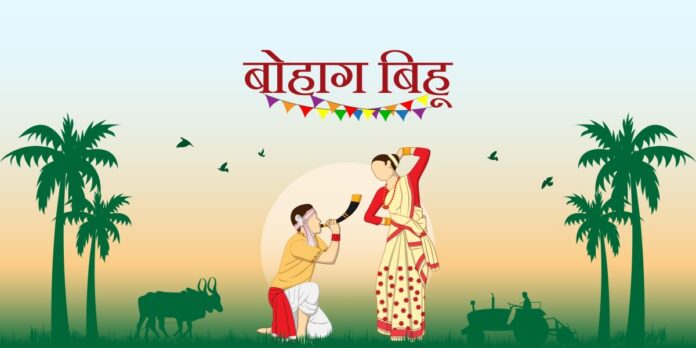Bohag Bihu 2024
Bohag Bihu, also known as Rongali Bihu, is one of the most significant festivals celebrated in the northeastern state of Assam, India. Bohag Bihu 2024 marks the beginning of the Assamese New Year and is a time of great joy and merriment.
Bohag Bihu Festival History
Bohag Bihu, also known as Rongali Bihu, is the most important of the three Bihu festivals celebrated in Assam, India, the other two being Kati Bihu and Magh Bihu. Bohag Bihu is celebrated in mid-April and marks the beginning of the Assamese New Year and the advent of the agricultural season. The festival is deeply rooted in Assamese culture and has a rich history that dates back to ancient times.
Ancient Origins
Bohag Bihu has its origins in ancient agrarian traditions. It is believed to have originated from the animistic practices of the early agrarian communities in Assam who celebrated the arrival of spring and the beginning of the sowing season. The festival also coincides with the traditional solar calendar followed in Assam, which divides the year into six seasons, with Bohag marking the beginning of the Ritu (season) of the same name.
Cultural Significance
Bohag Bihu holds immense cultural significance in Assamese society. It is a time when communities come together to celebrate and offer prayers for a bountiful harvest. The festival is also associated with the worship of cattle, as cows and bullocks play a crucial role in agriculture. Cattle are bathed, adorned with garlands, and worshipped as a symbol of prosperity and wealth.
Symbol of Unity
One of the most remarkable aspects of Bohag Bihu is its ability to transcend barriers of caste, creed, and religion. The festival is celebrated by people from all walks of life, including Hindus, Muslims, and tribal communities, making it a symbol of unity and diversity in Assam. During Bohag Bihu, people forget their differences and come together to celebrate the joyous occasion.
Evolution Over Time
While Bohag Bihu has its roots in ancient agrarian traditions, it has evolved and has incorporated elements from various cultures and communities. The festival is not just a celebration of agriculture but also a celebration of life, fertility, and the vibrancy of nature. It is a time for new beginnings and renewal, as people bid farewell to the old year and welcome the new with open arms.
Bohag Bihu Festival Date
- Date: Bohag Bihu is celebrated in the month of Bohag, which falls in mid-April according to the Gregorian calendar.
- Duration: The festival typically lasts for seven days, with each day holding its significance and rituals.
- In 2024, Bohag Bihu will be celebrated with traditional fervor and enthusiasm on from April 14th to April 20th.
Bohag Bihu Meaning
- Bohag or Rongali: The term “Rongali” in Rongali Bihu signifies merriment and joy, which are integral parts of the festival.
- Cultural Symbolism: Bohag Bihu is a celebration of life, fertility, and the vibrancy of nature as it ushers in the Assamese New Year.
Bohag Bihu Celebrations
Bohag Bihu, also known as Rongali Bihu, is one of the most important festivals celebrated in the northeastern state of Assam, India. It marks the beginning of the Assamese New Year and is a time of great joy and merriment. The festival is celebrated with traditional fervor and enthusiasm, and the celebrations typically last for several days. Here are some of the key aspects of Bohag Bihu celebrations in India:
Traditional Attire
- Women: Women dress up in traditional Assamese attire, which includes the mekhela chador, a two-piece garment consisting of a skirt and a wraparound shawl.
- Men: Men wear dhoti kurta, a traditional outfit consisting of a long shirt and a wrapped-around lower garment.
Music and Dance
- Bihu Dance: The festival is incomplete without the Bihu dance, a traditional Assamese dance performed by men and women. The dance is characterized by brisk steps, rhythmic movements, and energetic music played on traditional instruments like the dhol (drum) and pepa (buffalo hornpipe).
- Husori: Another traditional dance form called Husori is also performed during Bohag Bihu. It involves a group of dancers moving in a circular formation, singing traditional songs and playing musical instruments.
Feasting
- Traditional Dishes: Special dishes are prepared during Bohag Bihu, including pitha (rice cakes), larus (coconut sweets), and various types of chutneys and pickles.
- Community Feasts: People also organize community feasts where they invite friends and family to share a meal and celebrate together.
Games and Sports
- Buffalo Fights: In some parts of Assam, traditional buffalo fights are organized as part of the Bohag Bihu celebrations.
- Other Games: Various traditional games and sports are also played during the festival, including egg fights and various types of races and competitions.
Community Bonding
- Visiting Friends and Family: Bohag Bihu is a time for people to visit their friends and family members, renew relationships, and strengthen community bonds.
- Exchanging Gifts: People exchange gifts and greetings as a gesture of goodwill and friendship.
Bohag Bihu is a festival that celebrates the spirit of spring and the joy of new beginnings. It is a time when people come together to celebrate their cultural heritage, express gratitude for the harvest, and welcome the New Year with hope and optimism. The festival is a testament to the rich cultural diversity of India and the spirit of unity and togetherness that binds its people.
Bohag Bihu, also known as Rongali Bihu, is a festival celebrated over seven days, each day known as ‘Chot’, ‘Kutum’, ‘Mela’, ‘Raati’, ‘Goru’, ‘Manuh’, and ‘Chera’. Each day has its own significance and rituals associated with it. Here’s a brief overview of how each day of Bohag Bihu is celebrated:
7 Days of Bohag Bihu
Chot (Day 1)
- The first day of Bohag Bihu is known as Chot.
- On this day, people clean their homes and surroundings and take a bath early in the morning.
- Women prepare special dishes like pitha (rice cakes), larus (coconut sweets), and other traditional delicacies.
- In the evening, people gather around a bonfire called ‘Meji’ and offer prayers for a prosperous year ahead.
Kutum (Day 2)
- The second day of Bohag Bihu is known as Kutum.
- On this day, people visit their relatives and friends to exchange gifts and greetings.
- Traditional games and sports are also organized, including buffalo fights and other traditional Assamese games.
Mela (Day 3)
- The third day of Bohag Bihu is known as Mela.
- On this day, people visit fairs and markets to buy new clothes, jewelry, and other items.
- Traditional cultural programs, including Bihu dances and songs, are also organized at various places.
Raati (Day 4)
- The fourth day of Bohag Bihu is known as Raati.
- On this day, young women and girls participate in traditional Raati Bihu songs and dances.
- The Raati Bihu songs are sung in groups, and the dancers perform intricate dance moves to the beats of the dhol and pepa.
Goru (Day 5)
- The fifth day of Bohag Bihu is known as Goru.
- On this day, cattle are bathed, adorned with garlands, and worshipped as a symbol of prosperity and wealth.
- Special dishes are prepared using milk and milk products as a way of honoring the cattle.
Manuh (Day 6)
- The sixth day of Bohag Bihu is known as Manuh.
- On this day, people take a bath early in the morning and wear new clothes.
- Traditional rituals are performed to seek blessings for the well-being of the family and prosperity in the coming year.
Chera (Day 7)
- The seventh and final day of Bohag Bihu is known as Chera.
- On this day, people visit their elders and seek their blessings.
- It is a day of feasting and merry-making, with people coming together to celebrate the end of the festival.
Conclusion
Bohag Bihu festivalis not just a festival; it is a celebration of life, culture, and tradition. It is a time when the people of Assam come together to rejoice in the beauty of nature and to welcome the New Year with open arms. Each day of Bohag Bihu is filled with its unique rituals and traditions, all of which contribute to the rich tapestry of Assamese culture.
FAQs
What are the 7 Days of Bohag Bihu?
Bohag Bihu, also known as Rongali Bihu, is celebrated over seven days, each with its own significance and rituals. The seven days are called ‘Chot’, ‘Kutum’, ‘Mela’, ‘Raati’, ‘Goru’, ‘Manuh’, and ‘Chera’.
- Chot: The first day when homes are cleaned, and a bath is taken early in the morning.
- Kutum: The second day for visiting relatives and friends, exchanging gifts and greetings.
- Mela: The third day for visiting fairs and markets, buying new items, and enjoying cultural programs.
- Raati: The fourth day for young women and girls to participate in Raati Bihu songs and dances.
- Goru: The fifth day when cattle are bathed, adorned, and worshipped.
- Manuh: The sixth day for taking baths, wearing new clothes, and performing rituals for family well-being.
- Chera: The seventh day for visiting elders, seeking blessings, and celebrating with feasts and merrymaking.
What is the Bohag Bihu significance?
Bohag Bihu is significant as it marks the Assamese New Year and the beginning of the agricultural season. It is a festival of joy, merriment, and renewal, celebrating life, nature, and the rich cultural heritage of Assam. It also symbolizes unity and diversity, as people from all walks of life come together to celebrate irrespective of caste, creed, or religion.
Which states celebrate Bohag Bihu as the main festival?
Bohag Bihu is primarily celebrated in the northeastern state of Assam, India. However, it is also celebrated in other northeastern states like Arunachal Pradesh, Manipur, Mizoram, Nagaland, and Tripura, albeit with different names and variations in customs and traditions.
How many kinds of Bohag Bihu are there?
Bohag Bihu is celebrated over seven days, each day known by a different name and associated with specific rituals and celebrations. These seven days together make up the festival of Bohag Bihu, also known as Rongali Bihu.





